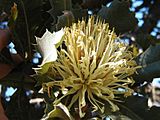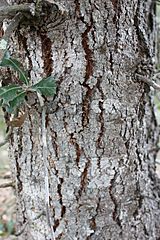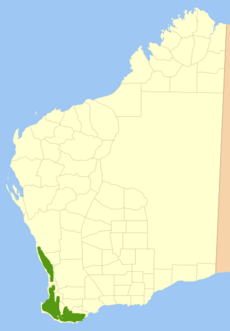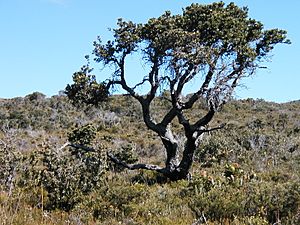Holly-leaved banksia facts for kids
Quick facts for kids Holly-leaved banksia |
|
|---|---|
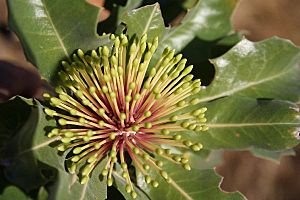 |
|
| Scientific classification | |
| Genus: |
Banksia
|
| Species: |
ilicifolia
|
| Synonyms | |
The Holly-leaved banksia (scientific name: Banksia ilicifolia) is a tree found in the Proteaceae plant family. It grows only in southwest Western Australia. This plant is special because its flowers grow in dome-shaped heads, not the usual long spikes seen on most other Banksia species.
The tree can grow up to 10 meters (about 33 feet) tall. Its name, both common and scientific, comes from its leaves. They look a lot like the prickly leaves of the English holly plant. The leaves are usually shiny green with sharp, jagged edges.
When the flowers first appear, they are yellow. As they get older, they turn pink and then red. This color change helps birds know when the flowers are open and ready to share their sweet nectar.
A botanist named Robert Brown first described this banksia in 1810. Even though it can look different in various places (like small shrubs near the coast), it's still considered one species. The Holly-leaved banksia grows best in sandy soils. Unlike some other banksias, it can regrow from its bark after a bushfire. It is not often grown in gardens.
Contents
What it Looks Like
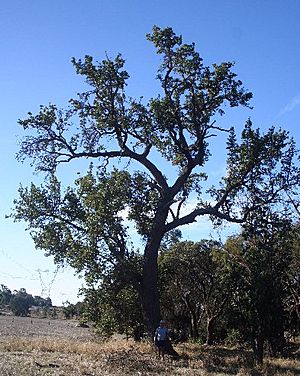
The Holly-leaved banksia can vary in how it grows. It is usually a tall tree, reaching up to 10 meters (33 feet) high. However, some plants along the south coast are smaller trees or even spreading shrubs. In the Margaret River area, it's often a small tree about 5 meters (16 feet) tall. It has many short branches, making its leaves look thick and close to the trunk.
This banksia has a strong trunk that can be up to 50 centimeters (20 inches) wide. Its bark is rough, grey, and about 2 centimeters (0.8 inches) thick. New branches mostly grow in summer. Young branches are hairy but become smooth after a few years.
The leaves grow on stems that are less than two years old. They are scattered along the stems but are crowded at the tips of the branches. The leaves are dark, shiny green, just like holly leaves. They can be egg-shaped, oval, or wavy. They are usually 3 to 10 centimeters (1.2 to 3.9 inches) long. Most leaves have up to 14 sharp "teeth" along their edges, but some leaves have smooth edges. The leaves have short stalks, about 0.3 to 1 centimeter (0.1 to 0.4 inches) long. Both sides of young leaves are hairy, but they become smooth as they get older.
Flowers and Seeds
Flowering happens from late winter to early summer. The flowers grow in dome-shaped heads, not the typical spikes of other banksias. These flower heads grow from stems that are about a year old. Each flower head is 7 to 9 centimeters (2.8 to 3.5 inches) wide and has 60 to 100 individual flowers.
The flower heads change color as they mature. They start yellow, then turn pink, and finally become red before they fall off. After the flowers are pollinated, one to three seed pods (called follicles) grow. These pods stay hidden in the woody base of the flower head. Each pod holds one or two seeds.
Young Plants
The first leaves of a seedling (called cotyledons) are dull green with no clear veins. They are shaped like wide ellipses, 8 to 13 millimeters (0.3 to 0.5 inches) long and 12 to 18 millimeters (0.5 to 0.7 inches) wide. The first true leaves of the seedling are crowded together. They look like those of the Scarlet banksia (Banksia coccinea). They have triangular lobes or "teeth" along their edges. Both the top and bottom of these young leaves are covered in hairs, as is the seedling stem.
In the Margaret River area, the Holly-leaved banksia can sometimes be confused with Banksia sessilis var. cordata. Both have prickly leaves and dome-shaped flower heads. However, the Holly-leaved banksia grows in deep sand, while the other grows on grey sand over limestone. Also, the seed pods of B. ilicifolia are embedded, while those of B. sessilis are loose.
How it was Discovered and Named
The first samples of Banksia ilicifolia were collected by a Scottish surgeon named Archibald Menzies in 1791. This happened during the Vancouver Expedition's visit to King George Sound. However, the species wasn't officially described then.
Later, in December 1801, Robert Brown collected more samples during the HMS Investigator visit to King George Sound. The expedition's artist, Ferdinand Bauer, also drew the plant. Sadly, Bauer's original drawing was destroyed in a fire in 1945. But a painting based on his drawing still exists in the Natural History Museum in London.
Robert Brown officially published the description of the species in 1810. He named it Banksia ilicifolia. The name comes from Latin words: ilex means "holly" and folium means "leaf." So, it means "holly-leaved."
In 1810, Brown also organized the Banksia genus into two main groups. He placed B. ilicifolia by itself in a group called Isostylis. This was because of its unusual dome-shaped flower heads. All other Banksia species, which have the typical long flower spikes, were put into the group called Banksia verae (meaning "true banksias").
Over time, some botanists thought certain forms of B. ilicifolia were separate species or varieties. For example, John Lindley described a shrubby coastal type as Banksia aquifolium in 1840. But now, this is considered the same species as B. ilicifolia. Even though the plant can look different, these variations are not enough to make them separate types.
Where it Lives
The Holly-leaved banksia is quite common in southwest Western Australia. It usually grows within 70 kilometers (43 miles) of the coast. Its range stretches from Mount Lesueur down to Augusta, and then east to the Cordinup River, past Albany.
It grows only in sandy soils and prefers low-lying areas. You can often find it in open woodlands with other trees like jarrah (Eucalyptus marginata), candlestick banksia (Banksia attenuata), and Western Australian Christmas tree (Nuytsia floribunda). Along the south coast, it grows in heathlands, sometimes forming groups with bull banksia (B. grandis).
The Holly-leaved banksia also gives its name to special woodlands called Banksia ilicifolia woodlands. These are found in low-lying areas near Perth that can get wet during certain seasons. It's also part of a very important and endangered plant community called the Assemblage of Tumulus Springs. This community has permanently moist, peaty soil.
Ecology and Life Cycle
The Holly-leaved banksia is an important food source for animals. For example, the honey possum (Tarsipes rostratus) feeds on its nectar from winter to early summer. Many types of honeyeater birds also visit and pollinate the flowers. The western spinebill (Acanthorhynchus superciliosus) especially likes this banksia.
A study near Perth found that birds and insects strongly preferred the yellow flowers. Birds like the red wattlebird and New Holland honeyeater were seen visiting. Native bees, beetles, and ants also visited the yellow flowers, which had the most nectar.
After a bushfire, the Holly-leaved banksia can regrow from special buds under its bark. Its seed pods open and release seeds after several years. This plant is somewhat "serotinous," meaning it needs fire to release its seeds. The other two species in its subgenus, Isostylis, are killed by fire and only regrow from seeds.
All banksias have special roots called proteoid or cluster roots. These roots help them get nutrients from the poor Australian soils, especially phosphorus. The plant grows many fine roots that form a mat under the soil. This helps it absorb nutrients very well.
The Holly-leaved banksia also has deep taproots that reach down to the water table. It needs access to groundwater to survive. If the water table drops too much, like it has in some areas near Perth due to water use, the health and number of Holly-leaved banksia plants can decrease.
Like many banksias in Western Australia, the Holly-leaved banksia is very sensitive to a plant disease called dieback. This disease is caused by a water mould called Phytophthora cinnamomi. Studies have shown that populations of B. ilicifolia are much smaller in areas affected by this disease.
Growing Holly-leaved Banksia
The Holly-leaved banksia is not often grown in gardens. It needs a sunny spot and sandy, well-drained soil to grow well. It's a slow-growing plant, taking up to ten years to flower from a seed.
Even though it grows slowly, its shiny green leaves and long flowering period make it a good plant for gardens. However, its prickly leaves can be a problem if they fall on lawns or paths. The seeds do not need any special treatment to grow and usually sprout in 22 to 41 days. Collecting the seeds can be difficult, and insects often eat them before they can be gathered.
See also
 In Spanish: Banksia ilicifolia para niños
In Spanish: Banksia ilicifolia para niños


